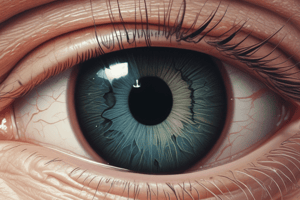Podcast
Questions and Answers
What is the primary role of eyelids in eye health?
What is the primary role of eyelids in eye health?
Lubrication and protection
Which structures play a role in the formation of the upper and lower eyelids?
Which structures play a role in the formation of the upper and lower eyelids?
- Maxillary process (correct)
- Oral process
- Frontonasal process (correct)
- Nasal process
The appearance of the eyelid fold marks the beginning of eyelid formation at ___ weeks of gestation.
The appearance of the eyelid fold marks the beginning of eyelid formation at ___ weeks of gestation.
6 or 7
What is the diameter of the palpebral aperture horizontal measurement at birth?
What is the diameter of the palpebral aperture horizontal measurement at birth?
Eyelids influence facial appearance and emotional expression.
Eyelids influence facial appearance and emotional expression.
Which glands open at the lid margin?
Which glands open at the lid margin?
What is the innermost layer of the eyelid?
What is the innermost layer of the eyelid?
The eyelid structures undergo development during ___ months of gestation.
The eyelid structures undergo development during ___ months of gestation.
Match the eyelid components with their descriptions:
Match the eyelid components with their descriptions:
Eyelid fusion occurs around 8 to 10 weeks of gestation.
Eyelid fusion occurs around 8 to 10 weeks of gestation.
Flashcards are hidden until you start studying
Study Notes
Importance of Eyelids
- Eyelids shield eyes from foreign objects, dust, harmful substances
- Lubricate eyes through tear spreading
- Blink reflex clears debris and refreshes tear film
- Regulate light entering the eye
- Influence facial appearance and emotional expression
Embryology
- Eyelids are derived from surface ectoderm
- Upper eyelids formed from the frontonasal process
- Lower eyelids formed from the maxillary process
- Development timeline:
- Appearance of eyelid fold marks: 6 to 7 weeks of gestation
- Eyelid fusion: 8 to 10 weeks of gestation
- Development of eyelid structures: 3 to 4 months of gestation
- Eyelid reopening: 5 to 6 months of gestation
Clinical Correlation (Embryological)
- Congenital Ectropion: eyelid turns outward
- Ankyloblepheron: eyelids are fused together
- Lid Coloboma: eyelid defect or gap
- Cryptophthalmos: complete or partial eyelid fusion
- Congenital Entropion: eyelid turns inward
Clinical Correlation (Other)
- Blepherophimosis: narrow palpebral fissure
- Epiblepheron: fold of skin at the eyelid margin
- Epicanthus: vertical fold of skin at the inner corner of the eye
Anatomy
- Upper eyelid:
- Extends from eyebrow to free margin
- Anatomical portions:
- Orbital portion (upper part close to the eyebrow)
- Tarsal portion (central part supported by the tarsal plate)
- Marginal portion (lower part near the lashes)
- Superior Palpebral Sulcus: groove that separates the orbital and tarsal portions
- Lower eyelid:
- Extends smoothly into the cheek
- Anatomical portions:
- Orbital portion (upper part closer to the eye socket)
- Tarsal portion (middle region supported by the tarsal plate)
- Ciliary margin (lower part near the eyelashes)
- Inferior Palpebral Sulcus: faint groove separating orbital and tarsal portions
Palpebral Aperture (Eyelid Opening)
- Diameter:
- At birth:
- Horizontal: 18-21 mm
- Vertical: 8 mm
- Adult:
- Horizontal: 28-30 mm
- Vertical: 9-11 mm
- At birth:
Lid Margin
- Marked by eyelashes and tarsal plate
- Contains:
- Meibomian glands (sebaceous glands) opening along the margin
- Ciliary glands opening near eyelashes
- Openings for the glands of Zeis and Moll
Clinical Correlation (Lid Margin)
- Cyst of Moll: cyst formed from a sweat gland
- Cyst of Zeis: cyst formed from a sebaceous gland
- Trichiasis: misdirected eyelashes growing inward
- Distichiasis: abnormal growth of eyelashes from the meibomian glands
Layers of Eyelids
- From outermost to innermost:
- Skin and subcutaneous areolar tissue
- Muscles of protraction (orbicularis oculi)
- Orbital septum (connective tissue barrier)
- Orbital fat
- Muscles of retraction (levator palpebrae superioris, superior tarsal muscle)
- Tarsus (connective tissue plate)
- Conjunctiva
Conjunctiva
- Innermost layer of the eyelid
- Transparent vascularized membrane
- Lines the posterior surface of the eyelids (palpebral conjunctiva)
- Connects to the conjunctiva of the eye (bulbar conjunctiva)
Studying That Suits You
Use AI to generate personalized quizzes and flashcards to suit your learning preferences.




